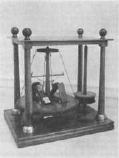
A working replica of Redheffer's perpetual motion machine built by Isaiah Lukens
In 1812 a man called Charles Redheffer appeared in Philadelphia. He had with him a miraculous perpetual motion machine that required no source of energy to run. Or so he claimed. He set up a working model of this machine on the outskirts of the city, near the banks of the Schuylkill River, and displayed it to curious Philadelphians. He also applied for funds from the city government to build a larger version of the machine.
On January 21, 1813 eight city commissioners visited Redheffer. Their intent was to inspect his machine in order to determine whether he should be granted the funds he had requested. Redheffer carefully watched them during their inspection, and he stopped them whenever they tried to get too close to the machine, claiming that he was concerned they might damage it. Nevertheless, one of the inspectors still managed to notice something strange about the machine: it was not working in the way that Redheffer claimed that it worked.
Redheffer had explained to the inspectors that his perpetual motion machine was providing the energy to power another, separate machine through a set of interlocking gears. However, the inspector noticed that the gears of the perpetual motion machine were worn in the wrong direction if it was really powering the other device. Instead, it was clear that power was being routed to the perpetual motion machine from the other machine.
Instead of openly challenging Redheffer on this point, the commissioners decided on a more subtle method to expose him. They instructed a local engineer, Isaiah Lukens, to build a machine that worked on the same principles as Redheffer's machine, but whose power source was even more ingeniously hidden (Lukens's machine is still owned by the Franklin Institution in Philadelphia). Then they displayed this machine to Redheffer.
Redheffer, seeing that his secret had been discovered, hurriedly left Philadelphia and moved on with his scam to New York City. Back then, news travelled slowly between cities, so no one there had heard of him yet. He opened an exhibit of his machine in New York City in 1813.
Again his machine attracted a great deal of attention, but one day Redheffer was visited by the mechanical engineer, Robert Fulton. Fulton noticed that the machine was wobbling slightly, and he deduced from this observation that the machine was being supplied its power by a hidden hand-crank. Whoever was turning the hand-crank was doing so in an irregular, jerky fashion that was causing the machine to wobble. The only question was where the hand-crank and its operator were hidden.
Fulton offered Redheffer a challenge. He said that he could expose the secret source of the machine's energy, and that if he failed to do so he would pay for any damages he might cause in trying. Redheffer agreed to this, and so Fulton immediately removed some boards from a wall neighboring the machine. A long hidden cord made of catgut was revealed.
Fulton followed this cord upstairs where he found an old bearded man sitting and eating a crust of bread with one hand, while he turned a hand-crank with the other. An angry mob, realizing the scam, demolished the perpetual motion machine, and Redheffer fled.
Links and References
- Angrist, Stanley W. "Perpetual Motion Machines." Scientific American, 218 (January, 1968): 114-22.
- Ord-Hume, Arthur W.J.G. Perpetual Motion: The History of an Obsession. New York: St. Martin's Press, 1977.


Comments